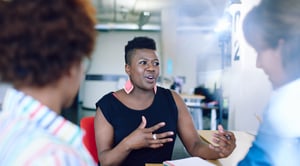In one of the most recent episodes of our Building the Bridge podcast, Dr. Wendy Oliver defined some of the most frequently heard terms in our K-12 education conversations. Consistent with the objectives of Building the Bridge, and with all our our work at EdisonLearning, it’s essential that educators, parents, students and other stakeholders are on the same page, part of the same productive conversation about teaching and learning. Listen below and read on to learn about these important terms in the K-12 education vocabulary.
IEPs and ILPs
Every parent has the right to be their child’s educational advocate. An IEP, which is an individualized education plan, or an ILP, an individualized learning plan, looks at a child’s individual needs. Often, those needs may come with a specific disability or an area for particular growth. Sometimes that’s a behavioral disability, sometimes it’s an academic need, and there are some very specific interventions that teachers are required to do in order to meet that child’s needs. As a result, there are strategies in place to help that child to be more successful. Those strategies are recorded in a legal document called an IEP or ILP. Teachers are required to review those documents, to sign off on them, and then to follow the modifications those documents dictate to help students who have specific needs. This ensures the students are getting equitable access and that they have the interventions they need based on their own disabilities or challenges.
One example that might be in some physical classrooms or online classrooms, is that a student might need some extended time on a test. Another example would be a student who has a processing disorder, which might require an assistant in the class to write out responses the student may verbalize.
There are many different kinds of adaptations or strategies that are in place and they are documented as IEPs and ILPs. They are reviewed with the student, the parent, and the education experts annually. This provides a community to support students.
Social-Emotional Learning (SEL)
Social-emotional learning is something that educators have been very cognizant of in education for years, but it certainly has taken the front seat of the conversations as a result of the pandemic.
SEL addresses students’ health and wellness, and it relates to school and classroom strategies that prioritize mental, emotional and social well-being. Given the global crisis we have experienced, in particular, now is a critical time to consider how it has impacted students. We need to figure out what can be done to help kids deal with the trauma, anxiety and fear that this situation has created to help them heal and be prepared for learning.
During the pandemic, children have been isolated. They haven’t had the social interaction they’d normally have. As everyone knows, especially with teenagers, social interaction is critical to their development.
Another area of struggle during the pandemic has come in the form of children who have experienced food shortages at home, especially because so many families have been in and out of work over the past year. Additionally, we have many, many families in the country who have lost loved ones, including loved ones that they maybe didn’t even see for a year that they were used to seeing regularly, or they just lost them very quickly and couldn’t see them to grieve or to mourn. All of those things are traumatic. Emotionally, children have been hurt through that and they have to grieve and process. Many of them have been isolated during those situations. We have to come back together and heal once we get through this pandemic, and children need coping strategies. Adults need coping strategies. Educators and parents are trying to find strategies to help these children and teenagers and young adults. There are a lot of grants available to help schools provide the resources and programs to help students. As we’re hoping to come out of the pandemic soon, this generation is going to suffer from this for quite a while. Hopefully, we can provide some strategies to address the trauma and promote healthy social-emotional well-being.
Online Learning vs. Blended Learning
Many parents and teachers think what they experienced during the pandemic is online learning or blended learning, and it’s not. In many cases, it is what Dr. Oliver calls “911 remote learning.” She does not want the emergency use of remote learning to be confused with the carefully crafted programs that have been in existence because, when executed properly, online learning and blended learning can be extremely rewarding for kids.
There is a variety of curriculum out there for online learning and there are many versions of online learning, but one example is where a child is participating online in some reteaching. Perhaps the student missed something and wants to practice and learn online to become stronger in that area. It could also be a matter of wanting to get ahead in a subject and enrolling in a class online. There are some really rich interactions that can take place. A student can work with their teacher and can also be paired with other students to do student-to-student interaction and communication.
Blended learning, on the other hand, could mean that a student is in a face-to-face classroom and then works online independently to get some personalized learning that is specific to his or her level and needs. This could also include working with other students on a project together through blended learning.
Typically, online and blended learning is using technology as a support structure so that learning can be individualized for students. It’s important to note that it’s not about the technology. It’s about the personalization and the individualization of learning for students. Technology just happens to be the tool that allows for it.


COMMENTS